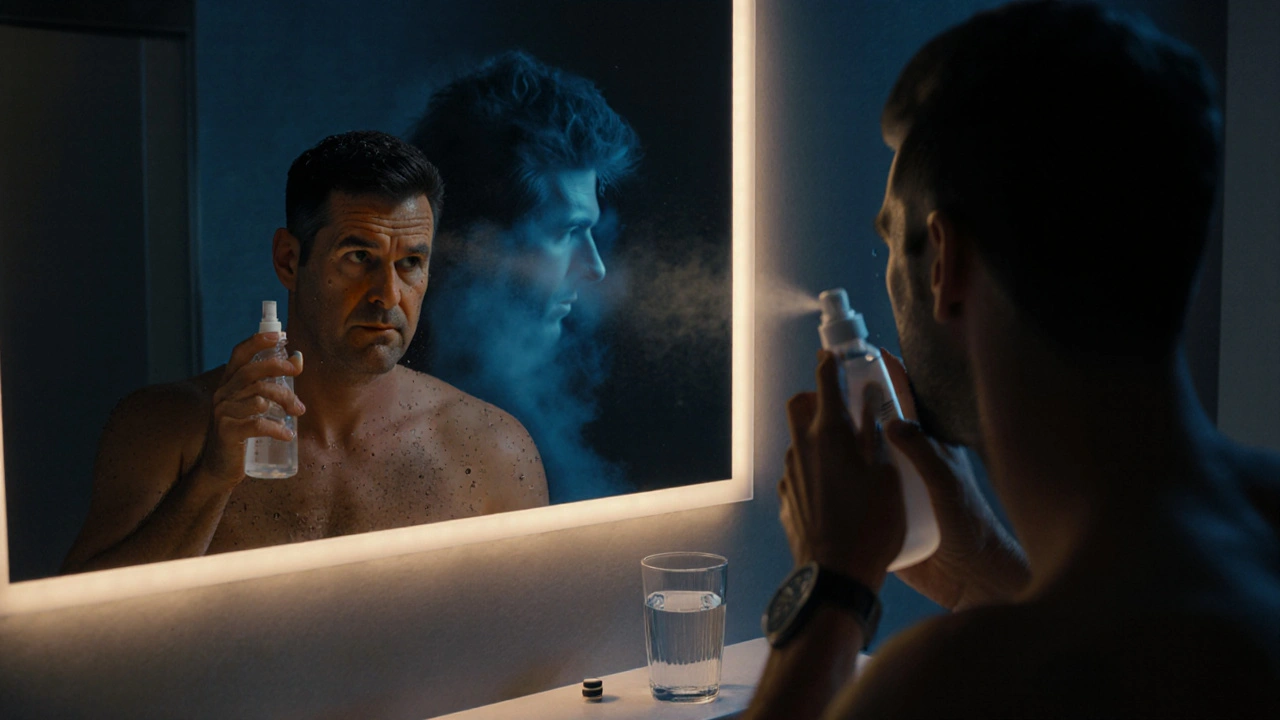5-Alpha-Reductase Inhibitor Comparison Tool
Select your condition and preferences to compare 5-alpha-reductase inhibitors:
5Dutasteride is a synthetic 5‑alpha‑reductase inhibitor that blocks both typeI and typeII isoforms of the enzyme, reducing dihydrotestosterone (DHT) levels in the prostate and scalp. It’s approved for benign prostatic hyperplasia (BPH) and marketed off‑label for androgenic alopecia. Compared with earlier drugs, Dutasteride achieves up to a 90% DHT reduction, delivering stronger clinical effects but also a broader side‑effect profile.
Why Readers Compare Dutasteride
People searching for “Dutasteride alternatives” usually have one of three jobs to finish:
- Pick a medication for BPH that balances symptom relief with tolerable side effects.
- Choose a hair‑loss treatment that fits their budget and lifestyle.
- Understand how newer drugs stack up against traditional botanicals and over‑the‑counter options.
Answering these jobs means looking at efficacy, safety, dosage, cost and real‑world usage data.
Key Players in the 5‑Alpha‑Reductase Space
The most common alternatives to Dutasteride fall into two groups: prescription‑only inhibitors and natural or adjunctive agents.
Finasteride is a typeII‑selective 5‑alpha‑reductase inhibitor approved for BPH at 5mg daily and for male‑pattern hair loss at 1mg daily. It reduces DHT by roughly 70% and has been on the market since 1992.
Saw palmetto is a plant extract that weakly inhibits typeI 5‑alpha‑reductase. It’s sold as a dietary supplement, typically 320mg twice daily, and is popular among men who want a “natural” BPH remedy.
Minoxidil is a potassium‑channel opener approved for topical treatment of androgenic alopecia. It works by prolonging the anagen phase of hair growth rather than lowering DHT.
Tamsulosin is an alpha‑1 adrenergic blocker that relaxes smooth‑muscle tone in the prostate, offering symptom relief without affecting DHT.
How the Drugs Differ: A Side‑by‑Side Look
| Attribute | Dutasteride | Finasteride | Saw Palmetto | Minoxidil (topical) | Tamsulosin |
|---|---|---|---|---|---|
| Primary Mechanism | Dual‑type 5‑alpha‑reductase inhibition | TypeII‑selective inhibition | Weak typeI inhibition (herbal) | Vasodilation & anagen prolongation | α1‑adrenergic blockade |
| DHT Reduction | ~90% | ~70% | ~20‑30% | N/A (doesn’t lower DHT) | N/A |
| Approved Indication (BPH) | Yes (0.5mg daily) | Yes (5mg daily) | Off‑label | No | Yes (0.4mg daily) |
| Approved Indication (Hair Loss) | Off‑label | Yes (1mg daily) | Off‑label | Yes (2% solution) | No |
| Common Side Effects | Decreased libido, ejaculatory dysfunction, breast tenderness | Sexual dysfunction (less severe), mild dizziness | Gastrointestinal upset, mild headache | Scalp irritation, itching | Dizziness, orthostatic hypotension |
| Typical Cost (USD/month) | ≈$30‑$45 | ≈$15‑$25 | ≈$20‑$30 (supplement) | ≈$25‑$40 (2% solution) | ≈$20‑$35 |
When Dutasteride Is the Right Choice
If a patient has moderate‑to‑severe BPH symptoms (IPSS≥8) and has not responded well to an α‑blocker alone, Dutasteride often provides the biggest DHT drop. The drug is also favored by men with early‑stage androgenic alopecia who want a systemic approach; studies from 2020‑2024 show an average 30% increase in hair count after 12months of 0.5mg daily.
Key indicators that Dutasteride may be optimal:
- Prostate volume >30mL and PSA >2.5ng/mL (but still under the cancer threshold).
- Desire for a once‑daily pill rather than multiple topical applications.
- No history of severe sexual dysfunction or breast pathology.
Because Dutasteride blocks both isoforms, it can lower PSA by about 50% after six months. Physicians therefore need to adjust PSA monitoring thresholds when patients start the drug.

When Alternatives Beat Dutasteride
Not every man needs the full 90% DHT suppression. For those with mild BPH or who are wary of sexual side effects, Finasteride offers a gentler curve-still enough to improve urinary flow for many patients while preserving a slightly higher DHT baseline.
Patients who prefer “natural” routes often start with Saw palmetto. Though its DHT drop is modest, a 2022 meta‑analysis found a 20% improvement in International Prostate Symptom Score versus placebo, with virtually no sexual side effects. The supplement is also cheap and easily combined with lifestyle changes (diet, pelvic‑floor exercises).
For hair‑loss‑only concerns, Minoxidil remains the go‑to. It bypasses the hormonal pathway entirely, which is helpful for men who have taken a 5‑alpha‑reductase inhibitor and still notice thinning in areas where DHT isn’t the primary driver.
Tamsulosin, while not a DHT‑targeting drug, is ideal when the main problem is urinary urgency rather than prostate size. It works within hours, unlike Dutasteride or Finasteride, which can take months to shrink the gland.
Safety Signals and Monitoring
All 5‑alpha‑reductase inhibitors share a black‑box warning for potential high‑grade prostate cancer risk. The FDA requires that doctors discuss this risk and continue regular PSA screenings. In practice, the absolute increase in cancer incidence is <0.5% but the concern persists.
Other safety considerations specific to Dutasteride:
- Longer half‑life (~5 weeks) means any adverse effect lingers after stopping the drug.
- Potential for persistent sexual dysfunction-studies suggest a 1‑2% rate of symptoms lasting >6months after discontinuation.
- Women who are pregnant must avoid handling crushed tablets; the compound can affect fetal genital development.
Finasteride’s side‑effect profile is similar but usually milder because it spares typeI inhibition. Saw palmetto carries minimal systemic risk but can interact with anticoagulants. Minoxidil’s scalp irritation is largely avoidable with proper application technique.
Cost‑Effectiveness Snapshot
When you add drug price, monitoring, and potential side‑effect management, the total cost of Dutasteride can rise quickly. A 2023 health‑economics model showed that for every 1,000 men treated for BPH, Dutasteride saved $85,000 in avoided surgeries but added $120,000 in drug expenses and $30,000 in adverse‑event care.
Finasteride’s lower price makes it the most cost‑effective for mild‑to‑moderate BPH, especially in health systems with strict formularies. Saw palmetto, while cheap, may require longer treatment duration to achieve comparable symptom relief.
For alopecia, patients often cycle between Finasteride (or Dutasteride) and Minoxidil, balancing cost and efficacy. Insurance coverage for Minoxidil varies widely; many patients pay out‑of‑pocket.
Choosing the Right Path: Decision Flow
Here’s a quick mental checklist to guide you:
- Is the primary issue BPH, hair loss, or both?
- Rate symptom severity on a 1‑10 scale. (>7 usually warrants Dutasteride or combination therapy.)
- Check for contraindications: recent prostate cancer, pregnancy (for women handling tablets), severe sexual dysfunction history.
- Consider budget. If Finasteride meets efficacy, it’s the cheaper route.
- Discuss with a urologist or dermatologist about monitoring plans (PSA, blood work, scalp evaluation).
Following this flow helps avoid the “one‑size‑fits‑all” trap and lands you on the treatment that fits your life.
Related Concepts Worth Exploring
Understanding Dutasteride in context opens doors to other topics:
- Prostate‑Specific Antigen (PSA) - how DHT inhibition skews PSA readings.
- Androgenic Alopecia - the role of DHT in pattern hair loss and why systemic inhibition can help.
- 5‑Alpha‑Reductase Isoforms - the biochemical difference between typeI and typeII and why dual inhibition matters.
- Alpha‑Blocker Therapy - when combining tamsulosin with a 5‑alpha‑reductase inhibitor is recommended.
- Pharmacogenomics - genetic variations that affect response to Dutasteride and Finasteride.
Each of these can be a standalone deep‑dive, but together they form the knowledge web around prostate health and male‑pattern hair loss.

Frequently Asked Questions
How long does it take for Dutasteride to improve BPH symptoms?
Most men notice a modest improvement in urinary flow after 3-6months, but maximal prostate shrinkage can take up to 12months of continuous therapy.
Can I use Dutasteride and Minoxidil together for hair loss?
Yes. Dutasteride lowers DHT systemically, while Minoxidil stimulates follicle growth locally. The combination is common and has shown synergistic gains in hair count.
What monitoring is required after starting Dutasteride?
Baseline PSA, liver function tests, and a digital rectal exam are recommended. PSA should be re‑checked at 6months and then yearly, remembering the drug halves PSA values.
Is Saw palmetto as effective as prescription inhibitors?
Evidence shows modest symptom relief, roughly 20% of the improvement seen with Finasteride. It’s a reasonable first step for mild BPH or for men who avoid pharmaceuticals.
Can women take Dutasteride?
Dutasteride is contraindicated in women who are or may become pregnant due to risk of fetal genital abnormalities. It’s generally not prescribed to women for any indication.
What are the most common side effects that cause discontinuation?
Persistent decreased libido and ejaculatory dysfunction are the top reasons patients stop Dutasteride. About 4‑5% of men report these issues severe enough to quit.
Is there a generic version of Dutasteride?
Yes, generic Dutasteride became available after patent expiration in 2018, which lowered the average price by roughly 30% compared with the brand name.
Should I stop Dutasteride before a PSA test for prostate cancer screening?
No. Stopping the drug abruptly can cause DHT rebound and mask true PSA levels. Instead, doctors apply a correction factor (multiply PSA by 2) when interpreting results.

Ryan Moodley
September 27, 2025 AT 18:41While most folks worship dutasteride as the ultimate DHT annihilator, the reality is far messier. The drug’s dual‑type blockade sounds impressive, yet it drags a legion of sexual side effects into the spotlight. Imagine trading a modest 70% DHT cut for a 90% plunge only to lose half your libido-what’s the point? Moreover, the black‑box warning about aggressive prostate cancer looms like a hidden sword. In the grand scheme, a more measured approach with finasteride often delivers similar urinary relief without the drama of hormonal havoc. Sometimes the quiet, steady path outweighs the flash of a full‑spectrum knockout.
carol messum
October 12, 2025 AT 09:57Finasteride feels like the sensible middle ground. It cuts DHT enough to help both BPH and hair loss without the heavier side‑effect load.
Craig Mascarenhas
October 27, 2025 AT 00:13Dutasteride is not as secret as some claim. It is just a stronger version of finasteride. The pharma push is real but not a conspiracy. Most users get the same benefit with less price. So choose wisely.
aarsha jayan
November 10, 2025 AT 15:30Hey friend, great job breaking down the options! 🌈 For anyone worried about the cost, remember that generic dutasteride has dropped in price since 2018. If sexual side effects are a concern, finasteride’s milder profile can be a lifesaver. And for the natural‑leaning crowd, saw palmetto can ease mild BPH symptoms while keeping the wallet happy. Keep exploring, and feel free to share how your journey goes-community thrives on stories!
Rita Joseph
November 25, 2025 AT 06:46When weighing dutasteride against alternatives, it helps to map your priorities. If you need the strongest DHT suppression for aggressive hair loss, dutasteride’s ~90% cut is hard to beat. But for mild BPH symptoms, finasteride often delivers comparable relief with fewer sexual side effects. Saw palmetto can be a starting point if budget constraints dominate your decision. Remember to schedule regular PSA checks, as dutasteride lowers PSA values by roughly half.
abhi sharma
December 9, 2025 AT 22:02Sure, because spending extra on dutasteride is always the smartest move.
mas aly
December 24, 2025 AT 13:19The comparison chart does a solid job of laying out costs and effects. It’s useful to see that finasteride generally costs half of dutasteride while still offering decent DHT reduction. Balancing severity, side‑effect tolerance, and budget is the key to a good decision.